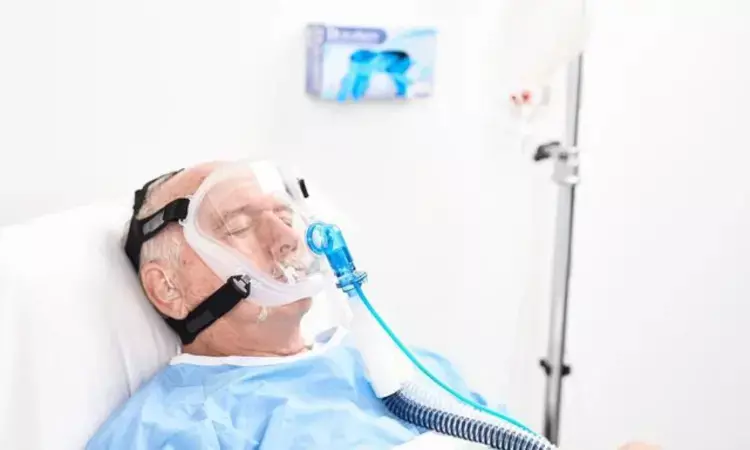- Home
- Medical news & Guidelines
- Anesthesiology
- Cardiology and CTVS
- Critical Care
- Dentistry
- Dermatology
- Diabetes and Endocrinology
- ENT
- Gastroenterology
- Medicine
- Nephrology
- Neurology
- Obstretics-Gynaecology
- Oncology
- Ophthalmology
- Orthopaedics
- Pediatrics-Neonatology
- Psychiatry
- Pulmonology
- Radiology
- Surgery
- Urology
- Laboratory Medicine
- Diet
- Nursing
- Paramedical
- Physiotherapy
- Health news
- Fact Check
- Bone Health Fact Check
- Brain Health Fact Check
- Cancer Related Fact Check
- Child Care Fact Check
- Dental and oral health fact check
- Diabetes and metabolic health fact check
- Diet and Nutrition Fact Check
- Eye and ENT Care Fact Check
- Fitness fact check
- Gut health fact check
- Heart health fact check
- Kidney health fact check
- Medical education fact check
- Men's health fact check
- Respiratory fact check
- Skin and hair care fact check
- Vaccine and Immunization fact check
- Women's health fact check
- AYUSH
- State News
- Andaman and Nicobar Islands
- Andhra Pradesh
- Arunachal Pradesh
- Assam
- Bihar
- Chandigarh
- Chattisgarh
- Dadra and Nagar Haveli
- Daman and Diu
- Delhi
- Goa
- Gujarat
- Haryana
- Himachal Pradesh
- Jammu & Kashmir
- Jharkhand
- Karnataka
- Kerala
- Ladakh
- Lakshadweep
- Madhya Pradesh
- Maharashtra
- Manipur
- Meghalaya
- Mizoram
- Nagaland
- Odisha
- Puducherry
- Punjab
- Rajasthan
- Sikkim
- Tamil Nadu
- Telangana
- Tripura
- Uttar Pradesh
- Uttrakhand
- West Bengal
- Medical Education
- Industry
Helmet Interface for Non-Invasive Ventilation Reduces Mortality in acute hypoxemic respiratory failure

Canada: A new systematic review published in the CHEST Journal has found that non-invasive oxygenation strategies can be effective in treating acute hypoxemic respiratory failure.
Several randomized controlled trials (RCTs) examining various non-invasive oxygenation techniques for the treatment of acute hypoxemic respiratory failure have recently been reported. The systematic review aimed to assess the non-invasive oxygen strategies effectiveness for acute hypoxic respiratory failure.
The systematic review searched several databases (e.g.- MEDLINE, EMBASE, Cochrane CENTRAL, CINAHL, Web of Science, MedRxiv, and Research Square) and used a random effects frequentist network meta-analysis.
The GRADE framework was used to rate the certainty of the evidence, and outcomes reported include mortality, mechanical ventilation, hospitalization and ICU duration, ventilator-free days, and comfort. The review included 36 trials with 7046 patients.
The study revealed the following clinical findings:
1. Helmet CPAP probably reduces mortality compared to SOT (Standard Oxygen therapy), with 231 fewer deaths per 1000 patients.
2. HFNC (High flow nasal cannula) probably reduces the need for invasive mechanical ventilation, with 103.5 fewer events per 1000 patients.
3. All non-invasive oxygenation strategies may reduce the duration of hospitalization as compared to SOT, with 4.84 days fewer and 1.74 days fewer, respectively.
4. Helmet bilevel ventilation and helmet CPAP may reduce the duration of ICU stay as compared to SOT. (Both low certainty)
5. SOT may be more comfortable than face mask non-invasive ventilation and no different in comfort compared to HFNC. (Both low certainty)
The study concluded that HFNC may be effective in reducing the risk of invasive mechanical ventilation and could be as comfortable as SOT.
“The study's findings suggest that the helmet interface for non-invasive ventilation may be an effective strategy in reducing mortality and the risk of mechanical ventilation, as well as the duration of hospital and ICU stay. the study provides valuable insights for clinicians treating patients with acute hypoxemic respiratory failure and highlights the importance of considering non-invasive oxygenation strategies in their treatment plans.” added the lead author of the study Dr. Tyler Pitre.
Reference:
Pitre T., Zeraatkar D., Kachkovski G., et al.; Non-invasive oxygenation strategies in adult patients with acute hypoxemic respiratory failure: a systematic review and network meta-analysis; CHEST Journal; 2023.04.19; doi: https://doi.org/10.1016/j.chest.2023.04.022
Dr. Mahalakshmi Sivashankaran joined Medical Dialogues as an Intern in 2023. She is a BDS graduate from Manipal College of Dental Sciences, Mangalore Batch 2022, and worked as a Junior Resident at VMMC & Safdarjung Hospital at the Department of Dental Surgery till January 2023. She has completed a Diploma in Executive Healthcare management from the Loyola Institute of Business Administration, developing skills in Healthcare Management and Administration. She covers several medical specialties including Dental, ENT, Diagnostics, Pharmacology, Neurology, and Cardiology.
Dr Kamal Kant Kohli-MBBS, DTCD- a chest specialist with more than 30 years of practice and a flair for writing clinical articles, Dr Kamal Kant Kohli joined Medical Dialogues as a Chief Editor of Medical News. Besides writing articles, as an editor, he proofreads and verifies all the medical content published on Medical Dialogues including those coming from journals, studies,medical conferences,guidelines etc. Email: drkohli@medicaldialogues.in. Contact no. 011-43720751


